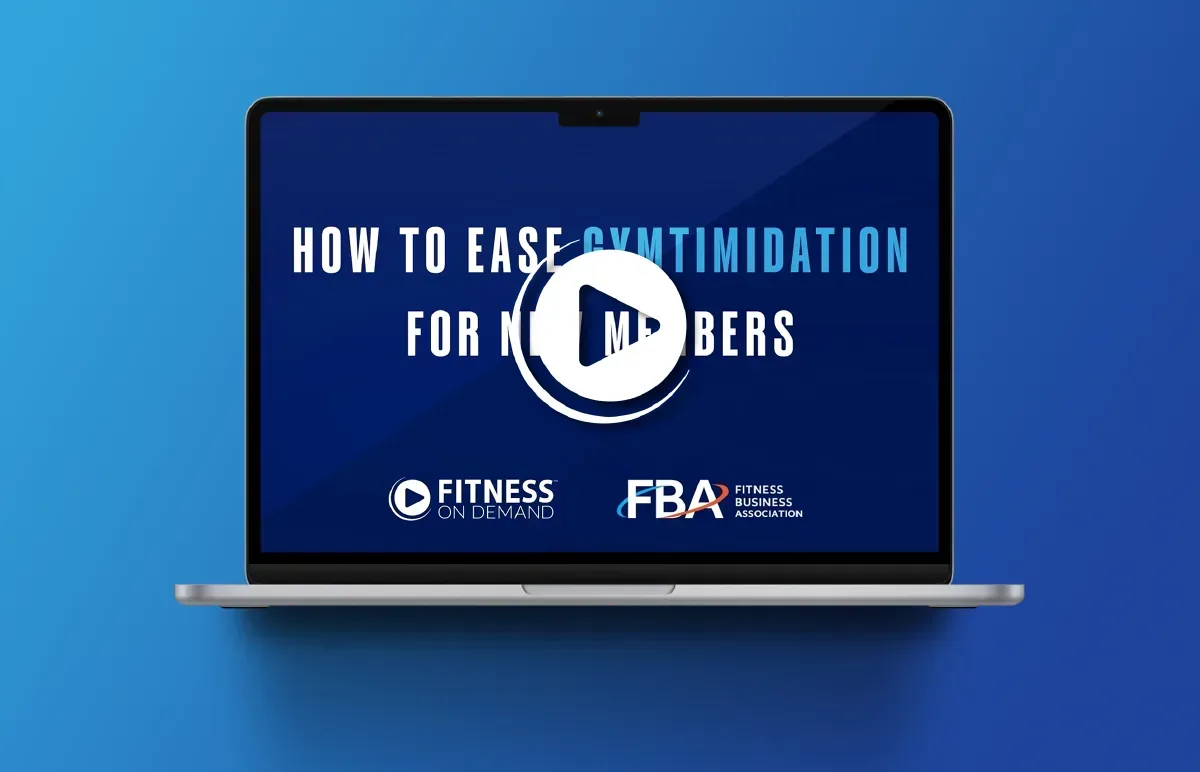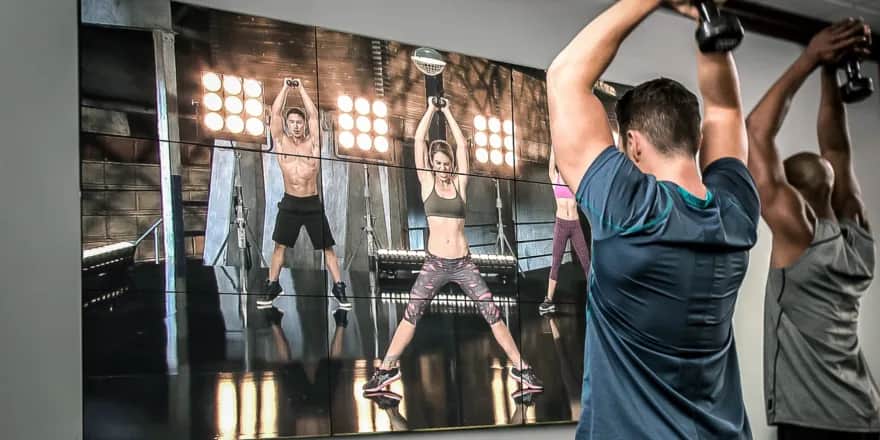
Get to know the essentials for a thriving facility.
In this quick 10-minute video about the importance of initial member interactions hear from Andy Peat, CEO at Fitness On Demand, along with a panel of industry experts including:
- Nik Herold, Customer Experience Director at Les Mills US
- Dr. Steve Boring, Fitness Director at Rochester Athletic Club
- Stefan Sleimann, Multi-Site Snap Fitness Owner
- Doug Mahlum, Owner/Operator of Montana Athletic Club
- John Prior, Owner of Snap Fitness Addlestone
Watch the full video below!
Andy Peat (00:08):
I am Andy, CEO of Fitness On Demand. Today we're going to talk about a major factor that impacts retention rates all over the industry. Gymtimidation. Gymtimidation is essentially the anxiety or the angst that a member will feel, whether they're new, predominantly new or existing who walk into a gym and really feel out of place. They feel like they don't necessarily belong because they're unsure of what to do, and they are given this perception, whether it be through marketing or other members, that everyone else knows what they're doing other than themselves, and it is easier to walk out the door than walk in and actually complete a workout.
They're essentially intimidated to walk into the gym and do a workout. This is essentially caused by a whole variety of things, whether it's social media, whether it's the marketing that's used with gyms today, showing perfect body, perfect form, perfect technique, but really it is the perception that is in the eye of the potential consumer. And how does it impact your club is crucial because if someone is feeling intimidated in coming into the gym in particular when they first join, they're less likely to come often within their first 60 days, and it is an absolute crucial time to have people attend the gym at least four times a month as a bare minimum in order to keep them longer as a member. It's simple. If people feel intimidated to come into the gym, they're less likely to actually come on their own.
We build member confidence. Now, there are an absolute ton of different ways to do this, but today we're going to focus on three key things. The first one is creating a strong onboarding process, then fostering a welcoming and supportive culture, and then ultimately, one of the most important pieces, making sure we give members the tools they need to be able to practice, experience and grow within your gym before they're able to step outside of their comfort zone.
Nik Herold (02:18):
We know now that about 80% of gym members don't want to stop using digital fitness. They want to continue to use that as part of their workout plan post pandemic. With that convenience comes flexibility, and we've known for a long time that members are going to want to out at home, and we've seen as high as 84% of 'em want to do that in addition to going into the gym. So those aren't going to change. Convenience and flexibility are going to be top of mind, but as one of my favorites in College Football League, Corso says Not so fast my friend. Connection is still a huge part of what members are looking for. So while those two things, they still rate being connected, the social aspect of things as being the primary driver that they come into your facility, and that's not going to go away
Andy Peat (03:16):
Ensuring that when a member joins, you understand that the first 30 days of the membership is where you need to be spending the absolute most amount of effort to create strong connections, focus on connections with other members, focus on connections with fitness professionals, focus on their attendance. Now, if we leave people to come at their own will, they're less likely to come than if they have appointments booked. So you can get the connection goal very simply by making times to see personal trainers, but not just one session book in the first four over their first four weeks. Book them in for group fitness classes, technique sessions, any sort of amenity that you have within your gym that you can get them to lock in and commit a time from day one gives you a greater chance of success for getting them to come to the gym for that magical four times a month, in particular, in the first 30 days, you want 'em to come at least six to eight times.
And then one of the most important pieces about the onboarding process is ensure that they see and feel progress. This can be through progress, strength, testing, progress, photos, maybe just a feeling a scale out of 10, but something from the start that needs to be measured after the first 30 days in a way that they'll likely to see improvement. If they see and feel progress, they're more likely to continue ensuring that the interactions in particular in the first month are really, really strong, and that's where the bookings and the attendance comes in. So even the simple hello and goodbyes when a member enters the gym, remembering their name, following up their first visit with a text message or a phone call, see how their body's feeling after their first wait sessions, but ensuring that they feel supported in their program and in the gym environment by your staff and your technology is extremely crucial. Here's our good friend, Dr. Steve Boring, the fitness director at the famous Rochester Athletic Club, to tell you a little bit more about how to create a supportive welcoming.
Dr. Steve Boring (05:26):
So you end up with this really bright, vibrant space and you see two or three people initially in there that came in as a group and you're like, you know what? I'm going to go in and join. You've now added that social aspect and that social aspect is one of the biggest pieces of how to personalize a club experience. I always say if I have one friend in the gym, I'm less likely to quit that gym if I know that they're there. That helps me because I've got a person there, I've got somebody in my space,
Andy Peat (05:55):
And our third point today is the point we're going to talk the most about, and that is the all important giving members the tools that they need to be able to feel comfortable and to be able to ensure that they are getting into a habit of coming to your gym. But most importantly, they're achieving a sense of progress. We're going to focus today on demand content and on demand classes. They're extremely critical. They're robust and diverse and really suit all fitness personas across experience levels. But don't take it from me. Take it from our good friend Stefan over at Snap Fitness UK who operates multiple sites and how he uses on-demand content.
Stefan Sleiman (06:34):
It just gives the member just a new perspective. It gives them a bit of autonomy. There's a lot of members that we see in Snap Fitness who are a bit shy and they're a bit intimidated and they're new and they want to do their own thing, so it gives them that possibility. All of a sudden, you're in the room by yourself. You have are in the zone. You have sort of a massive screen that you can look at and you can just choose whatever workout you want to do, and then you can just get on with it and then it helps as well. Members that, like I said, are a bit more shy to get into a routine that they can maybe work up to at some point. Going into a big class with a lot of people,
Andy Peat (07:11):
Given your members a really simple way to be able to try out classes on their own terms at their own time, is a really great way to relieve gymtimidation. Once they try the class, build up a little bit of confidence, whether it be at home or in the gym on their own, they're more likely to try some of the more group live instructor classes that your club may offer, and it will really help to build up their confidence. We see this work really well over in the Montana Athletic Club, and here's Doug to explain how
Doug Mahlum (07:42):
Many people are a bit nervous about how to walk into a class. Les Mills classes can be intimidating for people that are unconditioned or older. They just get intimidated. But to be able to say, put that up on their computer or on their app, and they can look and they can see, and they can see how the moves work, I think that's a huge benefit for them. They have the opportunity to go out and watch the videos and practice before they even get to class. I think that takes a lot of the intimidation out of it.
Andy Peat (08:24):
One of the real core benefits of an on demand class schedule and tool within your fitness facility is it does in fact increase your live class participation. In fact, just over one in three people who currently attend a live class have done so by participating in a digital on demand class first, which has really broken down the barriers of gymtimidation builds up their confidence and being able to now proceed into a live class environment. And this is absolutely crucial to help achieve loyalty by gaining a sense of community and connection. Once they're in a live class, they're meeting fellow members, they're meeting fellow instructors, they're laughing in a positive way, and then they get that real sense of community. No one drives community better. Then our next showcase, which is JP over in Snap Fitness in the UK, who recently shared his impact of on-demand classes within his fitness facility.
John Prior (09:23):
Sometimes people may be a little bit apprehensive at a class environment, and it's that first step into building the community or experience in a group exercise surrounding. So it's a nice way to start because they can be on their own. We tend to normally do the FOD classes with new prospective members or even new members and existing members, and it helps because it gives them the confidence in themselves to experience that environment, which we are about utilizing the whole facility. So it's definitely a powerful tool for that. Yeah,
Andy Peat (09:55):
In conclusion team, gymtimidation is real. That's the facts. No gym operator is out there trying to make their gym more intimidating. It's just something that naturally happens as we move through the membership sales cycle. It's just part of it, but by spending a little bit of time becoming aware on how your gym may possibly be, sending a gymtimidation vibe out to your members and particularly your new members, is really, really crucial.
Like I said, ensure that that first 30 days people are feeling that sense of progress. You're setting yourself up for success to get attendance at least four times through bookings and connections, but ultimately using the right tools. And we talked a lot today and we've seen through a lot of our videos, the success that comes with on demand classes and on-demand content and how members practicing and doing it on their own time boost their confidence to be able to then go do it with a group.
We appreciate your time. Make sure you get in touch with us with any of your fitness operations concerns, and would love to talk to you about Fitness On Demand.

Author
Tiarre Sales
Tiarre Sales is a rising marketing professional at Fitness On Demand, where she leads SEO, inbound strategies, and website optimization with a unique blend of creativity and commitment. She’s passionate about creating seamless customer experiences and building actionable strategies that drive authenticity, embrace diversity, and deliver measurable growth.
